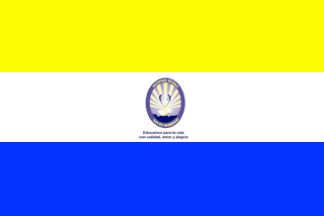 image by Ivan Sache, 11 September 2022
image by Ivan Sache, 11 September 2022
Last modified: 2024-03-02 by rob raeside
Keywords: education |
Links: FOTW homepage |
search |
disclaimer and copyright |
write us |
mirrors
See also:
 image by Ivan Sache, 11 September 2022
image by Ivan Sache, 11 September 2022
Institución Educativa Antonio Derka Santo Domingo was established in Medellín
(Antioquia Department) by Resolution No. 4,907 of 6 May 2008, as the merger of
two schools named for Antonio Derka and St. Dominic Savio, respectively.
The symbols of the school are described in the Manual de Convivencia as
follows:
The flag is rectangular, composed of three equal horizontal stripes,
blue, yellow and white, charged in the center with the school's coat of arms.
Blue symbolizes loyalty, confidence, knowledge, intelligence, faith and
tranquillity.
Yellow symbolizes glee, felicity, intelligence, energy, mind
power and spirit.
White symbolizes purity, light, transparency, perfection,
harmony and tranquillity.
The coat of arms is composed of:
- a book,
symbolizing knowledge and power of people's transformation
- mountains,
emphasizing willingness to get rid of difficulties and to reach goals with force
and perseverance
- mind openness to the horizon, representing the feeling of
belonging and identity with the territory and the ancestors.
- human figures,
meaning that education allows integral development of students, who are the
center of our force, to be free, autonomous and responsible.
- the sun,
representing spiritual power, life-generating energy and the bright force that
opens the mind through knowledge.
https://derkasantodomingo.edu.co/images/Pdf/MANUAL_DE_CONVIVENCIA_version_final_junio_2016.pdf
- Manual de Convivencia, June 2016
Ivan Sache, 11 September 2022
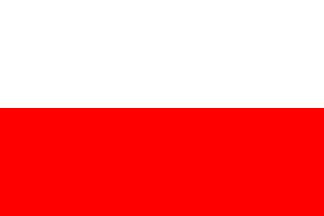 image by Ivan Sache, 05 July 2011
image by Ivan Sache, 05 July 2011
"Institución Educativa Antonio García Paredes" was established on 6 August
2003 in Popayán (Cauca Department) by Municipal Decree No. 139, merging "Colegio
Antonio García Paredes" and four other educational institutes. The institute is
named for the teacher and inspector Antonio García Paredes.
The flag of the institute is shown graphically on the website of the institute
as horizontally divided white-red.
Source:
http://www.ieagp.net/historia.htm
Ivan Sache, 05 July 2011
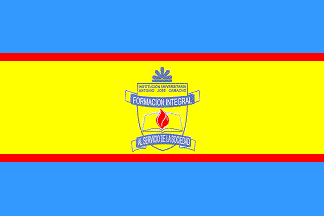 image by Ivan Sache, 31 July 2014
image by Ivan Sache, 31 July 2014
Institución Universitaria Antonio José Camacho (UNIAJC) is a public institute
located in Cali (Valle Department). Recognized in 2007 by Decree No. 963 of the
Ministry of National Education, UNIAJC succeeded Instituto Tecnológico Municipal
Antonio José Camacho, which had been established in 1993 by the Municipality of
Santiago de Cali (Decree No. 029), itself succeeding Escuela de Tecnología en
Electrónica, which had been established in 1966 by Tulio Ramírez. The remote
forerunner of UNIAJC is indeed a technical and industrial school established in
1933 by the Municipal Councillor Antonio José Camacho and renamed in 1945
Instituto Técnico Industrial Antonio José Camacho.
The flag of UNIAJC is horizontally divided blue-yellow-blue (c. 1:2:1) with a
thin red stripe between the coloured stripes, and the emblem of the institute in
the middle. Blue is a symbol of energy. Yellow is a symbol of spiritual,
emotional, and physical resources. Red is a symbol of passion, enthusiasm, and
motivation.
The emblem of the institute is surmounted by a blue rising sun, symbolizing the
growth of the institute and joy. The blue colour here represents God's will. The
open book represents a permanent commitment to change and a sum of fecund,
enlightening pages. It is charged with flames, representing knowledge as a
source of light. The shield is superimposed by two blue scrolls inscribed with
"FORMACION INTEGRAL" (top) and "AL SERVICIO DE LA SOCIEDAD" (bottom) (Integral
Education to the Service of Society]. On the flag, the parts shown in white on
the self-standing emblem (book pages, scrolls) are shown in yellow.
Source:
http://www.uniajc.edu.co/index.php/la-institucion/institucional-simbolo -
UNIAJC website
Ivan Sache, 31 July 2014
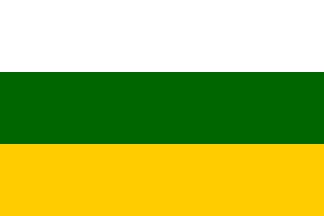 image by Ivan Sache, 03 October 2014
image by Ivan Sache, 03 October 2014
Institución Educativa Antonio Lizarazo was established in Palmira (Valle
Department) by Decree No. 1,640 of 24 August 1994 and inaugurated on 28 December
1994. Classes started on 10 January 1995.
The institute is named for the writer, journalist and politician José Antonio
Osorio Lizarazo (1900-1964), who was among the introducers of urban novel in
South America.
The flag of the institute is horizontally divided white-green-yellow.
Source:
http://antoniolizarazo.edu.co/acerca-de/simbolos/ - Institute's website
Ivan Sache, 03 October 2014
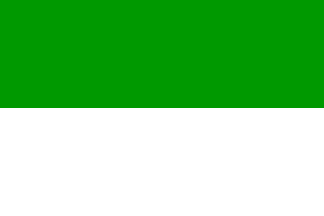 image by Ivan Sache, 03 December 2014
image by Ivan Sache, 03 December 2014
Colegio Antonio María Claret was established on 6 February 1956 in Quidbo
(Chocó Department) by the Apostolic Vicar Pedro Grau Arola, as Colegio
Claretiano. Institución Educativa Antonio María Claret was established in April
2004 as the merger of Colegio Antonio María Claret, Escuela Urbana Mixta,
Escuela Rural Mixta, Escuela Rural Mixta la Paloma and Escuela Rural Mixta la
Baudata. The institute is named for the Catalan priest Anthony Mary Claret
(1807-1870; canonized on 7 May 1950 by Pope Pius XII), who founded on 16 July
1849 the Claretians' congregation.
The flag is horizontally divided green-white. Green is a symbol of hope and of
the Chocó natural environment. White is a symbol of integrity and of mind
limpidity.
Source:
http://disensofft.com/ieclaret/insimias.php - Institute's website
Ivan Sache, 03 December 2014
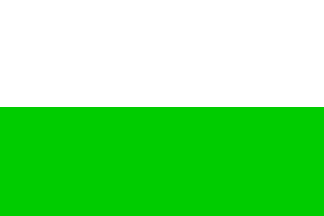 image by Ivan Sache, 10 January 2004
image by Ivan Sache, 10 January 2004
The College was founded in 1943. Its flag is horizontally
divided yellow-green.
Source: <www.voluntad.com.co>,
located by Dov Gutterman.
Ivan Sache, 10 January 2004
Colegio Antonio Nariño was founded in 1943 in Barrancabermeja (Santander
Department). The institute is named for the precursor of the national
independence, Antonio Nariño (1765-1823), President of the Free State of
Cundinamarca (1811-1813) and Vice President of Gran Colombia (1821).
The flag of the institute is horizontally divided yellow-green.
Source:
https://web.archive.org/web/20040224004927/http://www.voluntad.com.co/voluntad/colegios/cdd0311/main.htm
- Institute's website (archived)
Ivan Sache, 19 September 2014
You reported this flag about 10 years ago at first time, and you wrote: "Its
flag is horizontally divided yellow-green." But flag image you posted is a
white-green flag.
Now you also reported that this flag was horizontally divided yellow-green, but
the linked (archived) page shows a white-green flag.
Do you have any other source having a description about a yellow-green flag?
Zoltan Horvath, 20 September 2014
The "yellow-green" is clearly a mistaken, which has to be corrected for "white-green".
The only source is the archived website, showing a white-green flag.
Ivan Sache, 20 September 2014
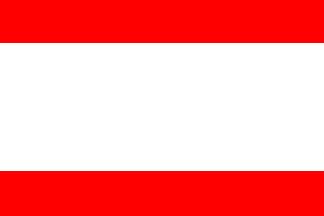 image by Ivan Sache, 25 July 2014
image by Ivan Sache, 25 July 2014
Colegio Antonio Nariño was established in Bogota on 8 February 1932. In 1964,
following the death of Cecilia Marroquín, owner and director of the institute
since 1938, the institute was transferred to the Congregation of the Brothers of
the Sacred Heart, founded in 1821 in France by the Reverend André Coindre
(1787-1826), and established in Bogota since 1890. The new owners decided to
maintain the original name of the institute.
The flag of the institute is
horizontally divided red-white-red (1:3:1). Red is a symbol of the ardor of the
youth, of the energy of the beginning of life, and of the push to initiate the
struggle for surpassing and for a better word. White is a symbol of the purity
of mind, of morality and peace.
http://can.corazonistas.edu.co/features_fullwidth.html - Institute's website
Ivan Sache,
25 July 2014
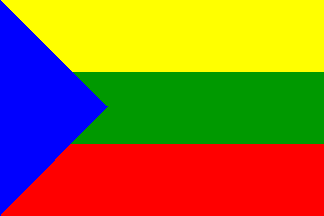 image by Ivan Sache, 21 October 2014
image by Ivan Sache, 21 October 2014
Institución Educativa Antonio Nariño is located in San Pablo (Nariño
Department).
The flag of the institute is horizontally divided yellow-green-red, with a blue
triangle placed along the hoist.
Source:
http://colnan.blogspot.fr/2008/01/bandera.html - Institute's blog
Ivan Sache, 21 October 2014
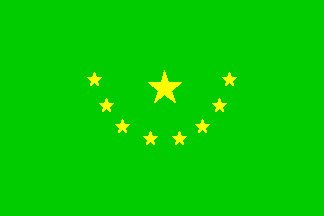 image by Ivan Sache, 26 September 2014
image by Ivan Sache, 26 September 2014
Institución Educativa Antonio Nariño, located in the village of Morritos,
part of the municipality of Filadelfia, originates in a school established in
1924 by Elvia Alzate in a small house built on a plot offered by Eliodoro
Morales. Modern buildings were erected in 1967 and 1974 with the support of the
Coffee Growers' Departmental Committee.
Institución Educativa Antonio Nariño was eventually established by Resolution
No. 711 of 25 March 2003, as the merger of Colegio Antonio Nariño and of another
seven schools.
The flag of the institute is green with a yellow star in the middle and, beneath
it, an arch of eight smaller, yellow stars. Green represents the natural
environment and agricultural production. It is also a symbol of hope. The
central star represents the central seat of the institute. The eight, smaller
stars, represent the other seats of the institutes. Yellow is a symbol of
knowledge.
Source:
http://institucioneducativaantonionarino.blogspot.fr/2012/11/simbolos_13.html
- Institute's website
Ivan Sache, 26 September 2014
"Institución Educativa Departamental 'Antonio
Nariño'" was founded in Bogotá in 1959 by the Department
of Cundinamarca (Decree No. 334) as "Colegio Departamantal
del Magisterio". In 1965, the institute moved to a brand new
seat and was renamed "Colegio Departamental 'Antonio
Nariño'" on 3 April 1965 (Decree No. 363).
On 9 April 1975, the institute was relocated to its present site
at Canelón, Municipality of Cajicá, Department of Cundinamarca.
The flag of the institute,
as shown graphically and described on the website
of the institute, is in proportions 3:5, red with a white
triangle placed along the lower edge of the flag and reaching its
upper edge, The upper half of the triangle is blue and the emblem
of the institute, with a crest made of five yellow teeth, is
placed in the triangle.
The triangle represents the permanent and unidirectional
projection forming the teaching process, involving three
components: the students, the teachers and the supports of
knowledge. It symbolizes also equality, perfection and
projection.
The sun symbolizes eternity, greatness, power, providence,
nobleness, fame and magnificence.
Yellow symbolizes the sun and its traditional meanings:
nobleness, wealth, power, light, constancy and knowledge.
Blue symbolizes the sky and its traditional meanings: justice,
truth, loyalty, charity and beauty.
Red symbolizes fire and its traditional meanings: strength,
victory, temerity, highness and ardor.
White symbolizes the moon and its traditional meanings: purity,
integrity, obedience, firmness, vigilance, eloquence and victory.
Black symbolizes the power and its traditional meanings:
prudence, sadness, rigor, honesty and obedience.
The flag was designed by Humberto Gómez Contreras and
Miguel Oswald Martínez Palacio.
The shield of the institute is quartered. The upper left quarter
shows a portrait of "The Sphinx", the famous Antonio
Nariño, after whom the institute was named. The upper right
quarter shows the map of Colombia with a handshake, which means
"Committed to the building of a better homeland". The
lower left quarter show the Olympic rings, representing sports.
The lower right quarter shows a book, representing knowledge. The
escutcheon in the middle is made of the shield of Cundinamarca.
The shield is placed on a disk representing planet Earth and
charged with the name of the institute. A scroll placed below the
disk is charged with the names of the municipality and
department. The colours, yellow, blue, red, are those of the
national flag of Colombia.
The emblem was designed by Javier Alfonso Cárdenas Alonso.
On the drawing of the flag, the emblem is shown in black and
white, with a red outline for the disk, scroll and quarters of
the shield. This seems to be a gross approximation, since another
drawing of the emblem shows it with blue background, yellow
quarters, white letters and red outlines. The emblem of
Cundinamarca is placed on a white disk.
However, on a photo
showing very partially the flag (and completely the emblem), the
letters appear in black, like on the drawing, and not in white!
Ivan Sache, 2 February 2009
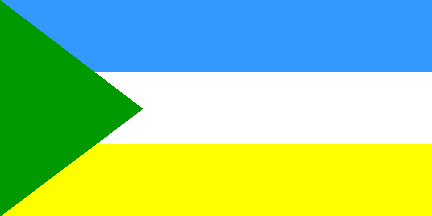 image by Ivan Sache, 31 January 2009
image by Ivan Sache, 31 January 2009
"Institución Educativa Municipal 'Antonio Nariño'"
(INEDAN) is located at Pasto, Department of Nariño.
The flag of the institute, as shown graphically and described by
Luis Eduardo Alvarez (the designer of the flag and emblem,
together with Giovanni Chamorro) on the website
of the institute, is horizontally divided blue-white-yellow
with a green triangle placed along the hoist and covering one
third of the flag length. The overall proportions are specified
as 1:2.
The blue stripe represents stability, depth and clarity of the
institutional horizon, linked to intelligence, knowledge and
sincerity.
The white stripe represents perfection and acts enlightened by
God.
The yellow stripe represents the sun light, joy, intelligence and
energy involved in the educational and cultural acts.
The green triangle represents hope, exuberance, fertility and
freshness characteristic of the natural environment of Pasto.
The municipal flag of Pasto has the
same design, but with different colours. This may not be purely
coincidental.
Ivan Sache, 31 January 2009
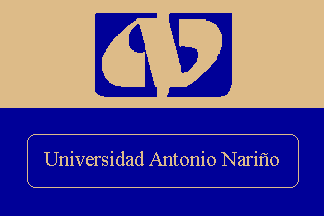 image by Carlos Thompson, 17 March 2003
image by Carlos Thompson, 17 March 2003
Universidad Antonio Narino, Bogota,
Colombia (Antonio Narino University) - I have not found this in
their website <www.uan.edu.co>,
but I have seen this flag flying over the main door and at the
director's office.
Carlos Thompson, 17 March 2003
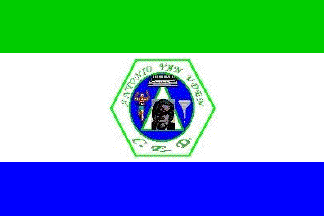 image by Ivan Sache, 28 January 2009
image by Ivan Sache, 28 January 2009
"Colegio 'Antonio Van Uden'" was founded in the
borough of San Pablo de Fontibón, Bogotá, by the Dutch Antonio
Van Uden, and transferred in 1958 to the Federal District of
Bogotá.
The flag of the institute, as shown graphically and described on
the website
of the institute, is horizontally divided green-white-blue
(1:2:1) with the emblem of the institute in the middle.
The emblem of the institute is made of a white triangle outlined
in green and charged with the portrait of Antonio Van Uden,
surrounded by three elements representing the three pillars of
the education provided in the college, "values, science and
technology", the whole placed on a blue disk outlined in
green, inscribed in a white hexagon outlined in green charged
with the name of the institute and representing the educational
duty of the institute, "Education with love, gratitude and
transcendence".
Ivan Sache, 28 January 2009